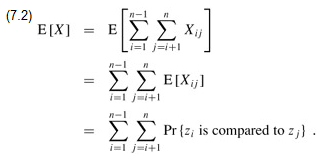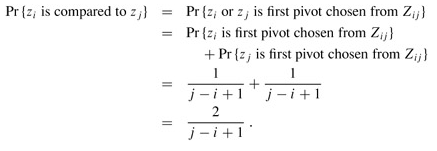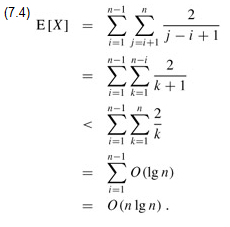SKEDSOFT
where we are considering whether the comparison takes place at any time during the execution of the algorithm, not just during one iteration or one call of PARTITION. Since each pair is compared at most once, we can easily characterize the total number of comparisons performed by the algorithm:

Taking expectations of both sides, and then using linearity of expectation and Lemma 5.1, we obtain

It remains to compute Pr {zi is compared to zj}.
It is useful to think about when two items are not compared. Consider an input to quicksort of the numbers 1 through 10 (in any order), and assume that the first pivot element is 7. Then the first call to PARTITION separates the numbers into two sets: {1, 2, 3, 4, 5, 6} and {8, 9, 10}. In doing so, the pivot element 7 is compared to all other elements, but no number from the first set (e.g., 2) is or ever will be compared to any number from the second set (e.g., 9).
In general, once a pivot x is chosen with zi < x < zj, we know that zi and zj cannot be compared at any subsequent time. If, on the other hand, zi is chosen as a pivot before any other item in Zij, then zi will be compared to each item in Zij, except for itself. Similarly, if zj is chosen as a pivot before any other item in Zij, then zj will be compared to each item in Zij , except for itself. In our example, the values 7 and 9 are compared because 7 is the first item from Z7,9 to be chosen as a pivot. In contrast, 2 and 9 will never be compared because the first pivot element chosen from Z2,9 is 7. Thus, zi and zj are compared if and only if the first element to be chosen as a pivot from Zij is either zi or zj.
We now compute the probability that this event occurs. Prior to the point at which an element from Zij has been chosen as a pivot, the whole set Zij is together in the same partition. Therefore, any element of Zij is equally likely to be the first one chosen as a pivot. Because the set Zij has j - i 1 elements, the probability that any given element is the first one chosen as a pivot is 1/(j - i 1). Thus, we have

The second line follows because the two events are mutually exclusive. Combining equations (7.2) and (7.3), we get that

We can evaluate this sum using a change of variables (k = j - i) and the bound on the harmonic series in equation (A.7):

Thus we conclude that, using RANDOMIZED-PARTITION, the expected running time of quicksort is O(n lg n).